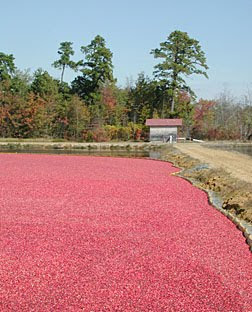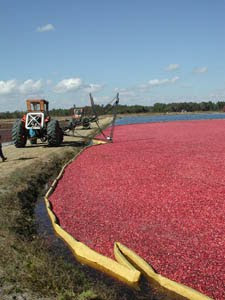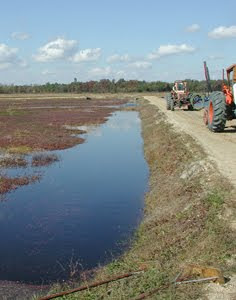 I hate to admit it because it seems silly now. When I first saw the arresting pictures of red seas of cranberries floating on bogs at historic Whitesbog in New Jersey, I just assumed that cranberry plants were aquatic. I imagined that, like lily pads, they grew in deep pools of water, and when the berries were ripe, they floated to the surface, ready for harvesting.
I hate to admit it because it seems silly now. When I first saw the arresting pictures of red seas of cranberries floating on bogs at historic Whitesbog in New Jersey, I just assumed that cranberry plants were aquatic. I imagined that, like lily pads, they grew in deep pools of water, and when the berries were ripe, they floated to the surface, ready for harvesting.
Anyone who has ever seen cranberries growing knows this notion was wrong, completely wrong. These native plants don’t live in water at all! Farmers simply flood their bogs at harvest time (usually October), then churn through the water with a large rotating reel that loosens the berries from their stems. Pic 2 shows a bog being flooded; the berries haven’t yet been loosened from the plants. The wheel-like churning apparatus near the tractor (look closely!) is ready to do this job.
Once afloat, the berries are corralled by booms (pic 3) and either drawn up conveyor belts into waiting trucks or sucked up with giant hoses. Not only are the plants not aquatic, but they will actually die if the water is not promptly drained off again. And the berries have to be processed into juice or sauce right away, as they will not keep once waterlogged.
As I learned during a visit to Whitesbog, a historic cranberry farm in the New Jersey Pinelands, where I took my pictures, this method, called wet harvesting, is completely modern and technically complex. Growers use a system of sluices that are opened and closed to efficiently flood and drain tidy rows of bogs in rapid succession. This preserves both the plants and the berries. (The good news is that it makes cranberry farmers much more productive than they once were. The bad news is that they now produce more berries than we need.)
 The method was introduced in the mid-twentieth century and drastically reduces the amount of labor that used to be required to pick cranberries. Almost all of America’s cranberries are now harvested this way; only the whole, fresh berries destined to be sold in plastic bags each fall are picked using the older “dry” method.
The method was introduced in the mid-twentieth century and drastically reduces the amount of labor that used to be required to pick cranberries. Almost all of America’s cranberries are now harvested this way; only the whole, fresh berries destined to be sold in plastic bags each fall are picked using the older “dry” method.
The extra labor and more careful handling means the fresh berries are pricier of course, but since I love their tang and color in all kinds of baked goods, I don’t mind. Every autumn I stash a few extra bags in the freezer to use the rest of the year. My cranberry-pear muffins with crystallized ginger are a family favorite. Or check my recipe archives for other cranberry treats.



Leave a Reply